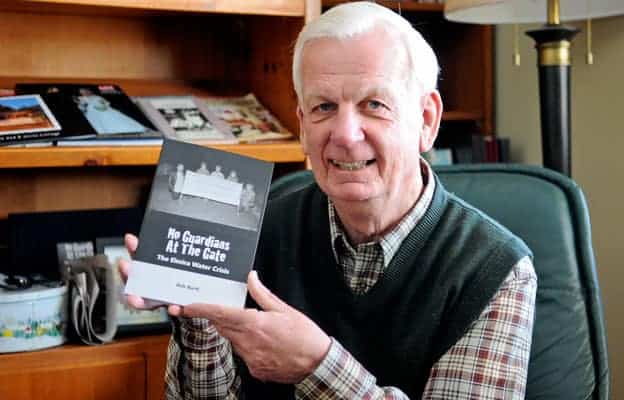In No Guardians at the Gate, author Bob Burtt tells the story of the Elmira water crisis.
![Bob Burtt spoke at the Elmira Library Mar. 11 to promote his book on the Elmira water crisis, No Guardians at the Gate. [Scott Barber / The Observer]](https://www.observerxtra.com/content/images/wp-content/uploads/2015/03/post_news_burtt.jpg)
A reporter and editor for more than four decades, Burtt spent 24 years with the Waterloo Region Record where he covered environmental issues, including the Elmira event.
Burtt spoke at the Elmira Library March 11, in an effort to help keep the community informed on this pivotal and still very much ongoing issue.
“The Elmira story has been cluttered with legal maneuvering, appeals, and science that isn’t easy to understand or explain,” he writes. “But, at its heart, the story is about a company that knew a lot about making chemicals, not much about protecting the environment; a provincial government that didn’t have the teeth, manpower or political will to enforce its laws; and residents who were prepared to do whatever it took to protect their community.”
The problem rose to the fore in the fall of 1989 when the Ministry of the Environment discovered high levels of the carcinogen nitrosodimethylamine (NDMA) in the drinking aquifers underneath Elmira.
The revelation led to the emergency construction of a pipeline from Waterloo, which supplies the town with water to this day.
“The book starts in 1989 with the water crisis and follows everything that really happened afterwards,” Burtt said. “It points the finger largely at the company and the Ministry of the Environment for failing to act, and failing to bring about a meaningful cleanup. It talks about the practices the way they were back in the 1940s and 50s, and how stuff was just sort of dumped and left to sit. At the time (before the crisis), they thought that it wasn’t a big problem because the general belief at the time was that the chemicals, over time, would neutralize and not be a problem. That of course turned out not to be true.”
Through meticulous research and a wide range of interviews, Burtt chronicled the issue from its roots in the 40s to the present day.
Chemtura – Uniroyal Chemical at the time, then later Crompton Co. a chemical plant in town, was found to be the cause of the contamination.
Eventually, a number of additional harmful toxins were discovered in Elmira, including chlorobenzene and DDT.
Public committees formed to pressure the government to take action, but the MOE failed to go far enough, Burtt argues.
And the cleanup, much of it at the public’s expense, and the legal wrangling continue.
Chemtura is currently undertaking a pump-and-treat process mandated by the province.
A deadline has been set for 2028, when Elmira’s aquifers are to be returned to drinking water standards.
But none of the Chemtura Public Advisory Committee, the township or Burtt are optimistic that is going to happen.
But there are positive lessons that can be drawn from the story.
“I think people can look to Elmira and see what a good citizen is in terms of all of the people who gave up their time and basically had their lives taken over for periods of time as advocates and activists,” Burtt said. “I think it is a really good example of how we as ordinary citizens need to be very vigilant and it’s not always good enough to assume that there is a government agency or that a company is going to do the right thing.”









